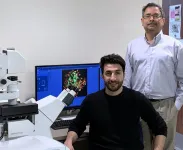(Press-News.org) An atmosphere is what makes life on Earth's surface possible, regulating our climate and sheltering us from damaging cosmic rays. But although telescopes have counted a growing number of rocky planets, scientists had thought most of their atmospheres long lost.
However, a new study by University of Chicago and Stanford University researchers suggests a mechanism whereby these planets could not only develop atmospheres full of water vapor, but keep them for long stretches. Published March 15 in the Astrophysical Journal Letters, the research expands our picture of planetary formation and could help direct the search for habitable worlds in other star systems.
"Our model is saying that these hot, rocky exoplanets should have a water-dominated atmosphere at some stage, and for some planets, it may be quite a long time," said Asst. Prof. Edwin Kite, an expert in how planetary atmospheres evolve over time.
As telescopes document more and more exoplanets, scientists are trying to figure out what they might look like. Generally, telescopes can tell you about an exoplanet's physical size, its proximity to its star and if you're lucky, how much mass it has. To go much further, scientists have to extrapolate based on what we know about Earth and the other planets in our own solar system. But the most abundant planets don't seem to be similar to the ones we see around us.
"What we already knew from the Kepler mission is that planets a little smaller than Neptune are really abundant, which was a surprise because there are none in our solar system," Kite said. "We don't know for sure what they are made of, but there's strong evidence they are magma balls cloaked in a hydrogen atmosphere."
There's also a healthy number of smaller rocky planets that are similar, but without the hydrogen cloaks. So scientists surmised that many planets probably start out like those larger planets that have atmospheres made out of hydrogen, but lose their atmospheres when the nearby star ignites and blows away the hydrogen.
But lots of details remain to be filled out in those models. Kite and co-author Laura Schaefer of Stanford University began to explore some of the potential consequences of having a planet covered in oceans of melted rock.
"Liquid magma is actually quite runny," Kite said, so it also turns over vigorously, just like oceans on Earth do. There's a good chance these magma oceans are sucking hydrogen out of the atmosphere and reacting to form water. Some of that water escapes to the atmosphere, but much more gets slurped up into the magma.
Then, after the nearby star strips away the hydrogen atmosphere, the water gets pulled out into the atmosphere instead in the form of water vapor. Eventually, the planet is left with a water-dominated atmosphere.
This stage could persist on some planets for billions of years, Kite said.
There are several ways to test this hypothesis. The James Webb Space Telescope, the powerful successor to the Hubble Telescope, is scheduled to launch later this year; it will be able to conduct measurements of the composition of an exoplanet's atmosphere. If it detects planets with water in their atmospheres, that would be one signal.
Another way to test is to look for indirect signs of atmospheres. Most of these planets are tidally locked; unlike Earth, they don't spin as they move around their sun, so one side is always hot and the other cold.
A pair of UChicago alumni have suggested a way to use this phenomenon to check for an atmosphere. Scientists Laura Kreidberg, PhD'16, and Daniel Koll, PhD'16--now at the Max Planck Institute for Astronomy and MIT, respectively--pointed out that an atmosphere would moderate the temperature for the planet, so there wouldn't be a sharp difference between the day sides and night sides. If a telescope can measure how strongly the day side glows, it should be able to tell whether there's an atmosphere redistributing heat.
INFORMATION:
Citation: "Water on hot rocky exoplanets." Kite and Schaefer, Astrophysical Journal Letters, March 11, 2021.
Funding: NASA.
The University of Chicago is a leading academic and research institution that has driven new ways of thinking since its founding in 1890. As an intellectual destination, the University draws scholars and students from around the world to its campuses and centers around the globe. The University provides a distinctive educational experience and research environment, empowering individuals to challenge conventional thinking and pursue field-defining research that produces new understanding and breakthroughs with global impact.
CABI has led the first study to explore the income and food security effects of the fall armyworm invasion on a country - revealing that in Zimbabwe smallholder maize-growing households blighted by the pest are 12% more likely to experience hunger.
Dr Justice Tambo, lead researcher of the study published in Food and Energy Security, sought to investigate the impact of the fall armyworm (Spodoptera frugiperda) on household income and food security as well as the extent to which a control strategy can help mitigate the negative impacts of the pest.
He, along with CABI colleagues from its centres in Kenya and Zambia as well as in collaboration with Zimbabwe's Ministry of Lands, Agriculture, Water and Rural Settlement, also found ...
More often than ever before, water available in rivers is at the mercy of climate change, international researchers collaborating on a worldwide study with Michigan State University have revealed. The finding could profoundly affect future water and food security around the world.
Yadu Pokhrel, associate professor of civil and environmental engineering in the MSU College of Engineering and a co-author of the study, said climate is the key driver in the current changes to global river flow.
"It's a noteworthy finding because as climate change impacts extreme flows, it could be worsening flooding or increasing water scarcity during dry seasons," Pokhrel explained.
Details of the new ...
The NANOGrav Collaboration recently captured the first signs of very low-frequency gravitational waves. Prof. Pedro Schwaller and Wolfram Ratzinger analyzed the data and, in particular, considered the possibility of whether this may point towards new physics beyond the Standard Model. In an article published in the journal SciPost Physics, they report that the signal is consistent with both a phase transition in the early universe and the presence of a field of extremely light axion-like particles (ALPs). The latter are considered as promising candidates for dark matter.
Gravitational waves open a window into ...
Researchers at the University of Gothenburg, Sweden, have now presented results that may change our basic view of how type 2 diabetes occurs. Their study indicates that free fatty acids (FFAs) in the blood trigger insulin release even at a normal blood-sugar level, without an overt uncompensated insulin resistance in fat cells. What is more, the researchers demonstrate the connection with obesity: the amount of FFAs largely depends on how many extra kilos of adipose tissue a person carries, but also on how the body adapt to the increased adiposity.
Worldwide, extensive research is underway to clarify exactly what happens in the body as type 2 diabetes progresses, and why obesity is such a huge risk factor for the disease. For almost 50 years, ...
Researchers at the University of Illinois Chicago have discovered that heparanase, HPSE, a poorly understood protein, is a key regulator of cells' innate defense mechanisms.
Innate defense responses are programmed cellular mechanisms that are triggered by various danger signals, which have been conserved in many species throughout evolution. These systems can be set into action by pathogens, such as viruses, bacteria and parasites, as well as by environmental toxins and dysfunctional cells that can accumulate in the body over time. A more thorough understanding ...
The U.S. criminal legal system has expanded at a rapid pace, even as crime rates have declined since the 1990s. As a result, individuals' interactions with and surveillance by law enforcement are now commonplace. But citizens experience different interactions, with people of color who live in impoverished urban communities having the most frequent encounters. A new study interviewed young Philadelphia men to determine their perceptions of and reactions to this phenomenon. Nearly all of the men of color said they stayed at home and avoided public spaces out of concern over the potential interactions with others that might draw police ...
UTICA, NY -- Brown fat, also known as brown adipose tissue (BAT), is a special type of fat that helps maintain body temperature. Importantly, brown fat is a biological fuel linked to metabolic rate and fat storage. In a recent publication, Dr. Zhiqiang Lin, Assistant Professor at the Masonic Medical Research Institute (MMRI) and senior author of the manuscript, successfully developed a new way to enrich isolation of brown fat cells for use in his biochemistry studies. "When faced with a scientific setback, we simply start tackling potential hurdles," said Dr. Lin. One of these was having a need to develop a better way to isolate these fat cells.
BAT is comprised of multiple cell types, which makes it difficult to ...
Between 2015 and 2017, Seattle, Washington, became the first U.S. city to increase its hourly minimum wage to $15, more than double the federal minimum wage and 60 percent higher than Seattle's previous minimum wage. A new study examined the impact of this change on public safety. The study was motivated by the idea that since crime is sometimes the result of material deprivation, changes in the minimum wage might have implications for criminal activity: Boosting the minimum wage could raise workers' salaries (which could be associated with reduced crime). But if higher minimum wages spur employers to substitute capital for labor, this could ...
Increases in the use of telehealth during the coronavirus pandemic among people with private insurance has occurred mostly among those who are more affluent and those who live in metropolitan areas, according to a new RAND Corporation study.
Researchers say the findings raise concerns that the pandemic may be worsening existing disparities in overall health care utilization.
Overall, the study found there was a 20-fold increase in the rate of telemedicine utilization following the outset of the pandemic in March 2020. At the same time, the rate of office-based medical encounters declined by nearly 50% and was not fully offset by the increase in telemedicine.
The findings are published online by the American Journal of Preventive ...
Robotics researchers are developing exoskeletons and prosthetic legs capable of thinking and making control decisions on their own using sophisticated artificial intelligence (AI) technology.
The system combines computer vision and deep-learning AI to mimic how able-bodied people walk by seeing their surroundings and adjusting their movements.
"We're giving robotic exoskeletons vision so they can control themselves," said Brokoslaw Laschowski, a PhD candidate in systems design engineering who leads a University of Waterloo research project called ExoNet.
Exoskeletons ...





